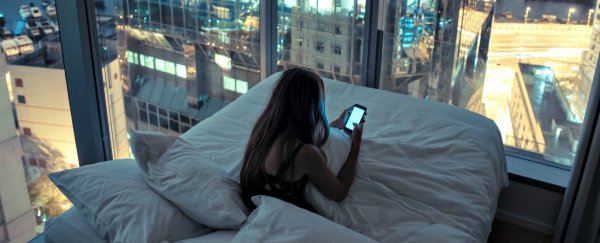New research has revealed that exposure to bright, blue-tinged light - similar to the kind emitted by your smartphone - can affect our metabolisms, potentially causing us to stack on weight, and mess with our bodies' ability to regulate glucose.
The study backs up previous observational studies, as well as research in mice, but takes things a step further by showing for the first time a direct link between light and our metabolism. And that's not the greatest news for all of us addicted to checking our phones in bed.
"These results provide further evidence that bright light exposure may influence metabolism," said lead researcher Kathryn Reid from Northwestern University in Illinois.
To be clear, the study didn't look specifically at smartphone light, but it did assess blue-enriched light, which are the blue wavelengths known to have the biggest impact on our circadian rhythm - the internal clock that's controlled by light and affects when we eat, sleep, and release hormones.
It's also the kind of light that just happens to be emitted by our phone and computer screens.
But what does all that have to do with metabolism? A couple of years ago, researchers found that people who get the majority of their bright light before midday weigh less than those who are exposed to bright light later in the day.
Studies in mice have also shown that when the animals are kept in constant light - rather than the natural day/night cycle - they can't properly breakdown glucose and they gain weight compared to a control group.
To test this link directly in humans, the team took 19 healthy volunteers and kept them in controlled conditions in the lab for four days, keeping them on the exact same diet.
For the first two days, they were all kept in dim light during their waking hours. On day three, they were randomly split into groups, with one group being exposed to bright, blue-enriched light for 3 hours before midday, and the other exposed to it in the evening.
The team found that the bright light exposure increased the body's resistance to insulin - which means that the participants were not as good as removing glucose out of their bloodstream when they had a few hours of bright light compared to when they were kept in dim light.
Particularly at night, the bright light exposure was associated with higher peak blood sugar levels. That's a pretty big deal, because having high blood sugar levels over time is associated with a higher risk for diabetes, and can also lead to people putting on body fat and gaining weight.
"Our findings show that insulin was unable to acutely bring glucose levels back to a baseline level following a meal with bright light exposure in the evening," said one of the researchers, Ivy Cheung.
These results are based on a small sample size, so more work is needed to verify the finds. But it's the first time this link has been directly observed in humans, so it's a pretty big deal.
The team wasn't able to say for sure why light exposure was having this affect, but it does suggest that by doing things like checking our phones on full brightness at night, we might be messing with our bodies. "The results of this study emphasise that our lighting environment impacts our health outcomes," says Cheung.
But there's a silver lining here - and that's the fact that we now know that we can control metabolisms through light exposure. For better or worse.
"It's cool that bright light has this effect, but we don't understand why yet," said Reid. "In theory, you could use light to manipulate metabolic function."
In the meantime, don't forget to make the most of Night Shift on your iPhone.
The research has been published in PLOS ONE.
